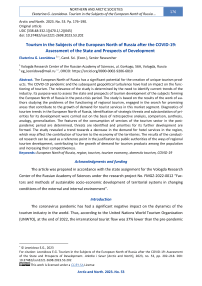Tourism in the Subjects of the European North of Russia after the COVID-19: Assessment of the State and Prospects of Development
Автор: Leonidova E.G.
Журнал: Arctic and North @arctic-and-north
Рубрика: Northern and arctic societies
Статья в выпуске: 53, 2023 года.
Бесплатный доступ
The European North of Russia has a significant potential for the creation of unique tourism products. The COVID-19 pandemic and the subsequent geopolitical turbulence have had an impact on the functioning of tourism. The relevance of the study is determined by the need to identify current trends of the industry. Its purpose was to assess the state and prospects of tourism development of the subjects forming the European North of Russia in the post-crisis period. The study is based on the results of the work of authors studying the problems of the functioning of regional tourism, engaged in the search for promising areas that contribute to the growth of demand for tourist services in this market segment. Diagnostics of tourism trends in the European North of Russia, identification of strategic threats and substantiation of priorities for its development were carried out on the basis of retrospective analysis, comparison, synthesis, analogy, generalization. The features of the consumption of services of the tourism sector in the post-pandemic period are determined, threats are identified and priorities for its further development are formed. The study revealed a trend towards a decrease in the demand for hotel services in the region, which may affect the contribution of tourism to the economy of the territories. The results of the conducted research can be used as a reference point in the justification by public authorities of the ways of regional tourism development, contributing to the growth of demand for tourism products among the population and increasing their competitiveness.
European North of Russia, region, tourism, tourism economy, domestic tourism, COVID-19
Короткий адрес: https://sciup.org/148329496
IDR: 148329496 | УДК: [338.48:332.1](470.1/.2)(045) | DOI: 10.37482/issn2221-2698.2023.53.202
Текст научной статьи Tourism in the Subjects of the European North of Russia after the COVID-19: Assessment of the State and Prospects of Development
The coronavirus pandemic has had a significant negative impact on the dynamics of the tourism industry in the world. Thus, according to the United Nations World Tourism Organization (UNWTO), at the end of 2022, the international tourist flow was 37% lower than the pre-pandemic
∗ © Leonidova E.G., 2023
This work is licensed under a CC BY-SA License value in 2019, amounting to 900 million tourists 1. However, the figure doubled compared to 2021, which is caused by the easing of pandemic restrictions in many countries. This indicates the rapid recovery of the industry after the crisis, which confirmed the high resilience of tourism to turbulent conditions noted by researchers [1, Skare M., Soriano D.R., Porada-Rochoń M.]. Russia is also showing signs of improvement in tourism, which has been hit hard by COVID-19 restrictions 2. The driving force of the industry was domestic tourism: the tourist flow at the end of 2022 was only 5% less than the level of 2019. In addition to the unfavorable influence of the medical and biological factor, the development of tourism in the country in 2022 was negatively affected by the geopolitical situation and economic turbulence, as a result, the volume of incoming and outgoing tourist flows decreased. Thus, epidemiological and sanctions restrictions update research aimed at assessing the state of Russian tourism in order to find ways to ensure its sustainable development. The tourism potential of many Russian regions remains untapped to the fullest extent, which is associated with existing imbalances in the distribution of demand for recreation between territories [2, Leonidova E.G.; 3, Lukin E.V., Leonidova E.G., Sidorov M.A.; 4, Leonidova E.G., Sidorov M.A.]. In post-pandemic conditions, it is important to understand how the demand for tourism services has changed in regions promising for tourism, in order to increase their competitiveness in the country’s tourism market. These include the European North of Russia (ENR), formed by the republics of Komi and Karelia, the Arkhangelsk, Vologda, Murmansk oblasts, as well as the Nenets Autonomous Okrug. The ENR is distinguished by the similarity of tourist and recreational resources, which are the basis for the creation of unique tourism products. Thus, many types of tourism are developing on the territory of the ENR: cultural and educational, environmental, business, water, cruise, Arctic, event, rural, religious, ethnographic, railway and others [5, Grushenko E.B., Lisunova E.A.; 6, Kondratyeva S.V.], which allows talking about the diversification of tourism activities in the region. Thus, the purpose of the study was to assess the state of tourism in the constituent entities of the European North of Russia in the post-Covid period 2021–2022, based on an analysis of the population’s demand for accommodation services, in order to determine the further vector of development of the industry. The information base was the works of domestic and foreign scientists dealing with the problems of tourism development in the post-Covid period, assessing its impact on economic parameters, information from state statistics bodies characterizing the population’s demand for accommodation facilities, data from the World Bank, the World Tourism Organization, and the NAFI analytical center.
Theoretical and methodological aspects of the study
The analysis of works of foreign authors revealed an increased interest in the study of domestic tourism after the COVID-19 pandemic — it became not only a catalyst for the recovery of the tourism sector in many countries [7, Rogerson C.M., Rogerson, J.M.], proved to be more resistant to the impact of COVID-19 than international tourism [8, Duro J.A., Perez-Laborda A., Fernandez M.], but also acted as an essential element of economic recovery as a whole after the pandemic [9, Arbulú I., Razumova M., Rey-Maquieira J. , Sastre F.; 10, Gössling S., Scott S., Hall M.; 11, Kreiner N.C., Ram Y.; 12, Woyo E.]. Some works indicate that domestic tourism is characterized by domestic demand and domestic supply, which are relatively independent of international shocks, which, along with its benefits to the economy (job creation, contribution to investment and production), is a factor in reducing economic vulnerability [13, Nguyen C.P., Su T.D.].
Recently, there has been interest in the study of domestic tourism and its economic assessment in Russia. The authors raise the problem of finding new strategic vectors for its development in the changed geopolitical conditions. It is stated that without a targeted increase in citizens’ incomes, it will hardly be possible to fulfill the goal of the national project “Tourism and hospitality industry” to achieve a twofold increase in the number of trips across the country by 2030: due to the low level of incomes, the demand for tourism does not yet have grounds to increase, and fulfillment of the stated indicators is possible only due to an increase in the frequency of trips of the solvent population [14, Simonyan G.A., Saryan A.A.]. The fact that a decrease in purchasing power remains a limiting factor for the development of domestic tourism is also stated in other studies [15; Donskova L.I., Barannikov A.L., Makovetskiy M.Yu.]. There are differences between territories in terms of the availability of tourism services for the population [16, Moroshkina M.V., Kondratyeva S.V.], intraregional disproportions between the amount of tourist flow and the development of tourism infrastructure [17, Ivanov I.A., Vasilyeva T.V., Krasilnikova I.N., Manakov A.G.].
Russian scientists have paid quite a lot of attention to revealing the prospects for the development of tourism in the European North of Russia. S.V. Kondratyeva emphasizes that one of the limitations hindering the growth of tourist flow to the region is the poor recognition of the tourism product in the domestic market [18, Kondratyeva S.V.]. She notes the importance of meeting the recreation and tourism needs of the local population based on the tourism resources of the region [19]. Other studies indicate that the tourism market in the region is at a stage of development, which is hampered by poor transport accessibility [20, Orlova V.S.], lack of tourism infrastructure, high cost of tourism services and difficult climatic conditions [21, Yakovchuk A.A.].
However, many researchers have identified attractive growth points for tourists that contribute to the influx of tourists into the region. These include the potential of gastronomic and ethnographic tourism [22, Pospelova S.V., Kutyeva E.R.], the creation of interregional tourist routes [23, Kozhevnikov S.A., Sekushina I.A.].
Summarizing the work on assessing the demand for tourism resources in the region by the population, it should be noted that they are mainly based on official statistics characterizing the state of the industry’s infrastructure (accommodation facilities, travel agencies, catering establishments, transport, tourist information centers). Information from Rosstat remains the main source of information on the development of tourism, although it needs to be expanded and detailed [24, Leonidova E.G., Sidorov M.A.; 25, Ovcharov A.O.; 26, Ovcharov A.O.]. At the same time, many authors often use absolute indicators in their analyses, which do not always objectively reflect the state of the subject under study. The analysis of the few works on the problems of the tourism industry of the subjects forming the European North of Russia, in which the calculation of relative indicators was used, taking into account the area and population, showed that the conclusions are formulated by the authors either on the basis of incomplete data characterizing the objects of tourism infrastructure [17, Ivanov I. A., Vasilyeva T.V., Krasilnikova I.N., Manakov A.G.], or on a narrow time interval that does not include an assessment of the state of tourism in the region in the post-pandemic period [2, Leonidova E.G.]. Thus, the above-mentioned actualizes the problem of assessing the recovery of the tourism industry of the ENR subjects after the COVID-19 pandemic in order to identify new trends and formulate a further vector of development.
It is known that statistics reflecting the development of Russian tourism are imperfect. The main source of information about the dynamics of regional tourism development is the data provided by collective accommodation facilities, which register travelers staying overnight. The study assumes that accommodation facilities are used mainly for tourism purposes, and the indicators characterizing them make it possible to adequately assess the dynamics of tourist demand for recreation in the region. To solve this problem, the following indicators were used:
-
• the number of people staying in collective accommodation facilities;
-
• the number of overnight stays in collective accommodation facilities;
-
• tourist load on the territory, allowing a more objective assessment of the tourist attractiveness of the region. It is defined as the ratio of tourist flow to the number of residents of the territory receiving tourists [28, Ivanov I.A.]. In this case, the tourist flow was estimated by the number of people staying in collective accommodation facilities.
2.9
2.8
2.7
2.6
2.5
2.4
2.3
2.2
2.1
To diagnose trends in the development of the tourism industry in the post-pandemic period, identify limitations and determine vectors for its further development, general scientific research methods were used: retrospective and comparative analysis, synthesis, analogy, generalization.
Research results
The coronavirus pandemic reduced the contribution of gross value added created by tourism to the economy of the Russian Federation (Fig. 1).
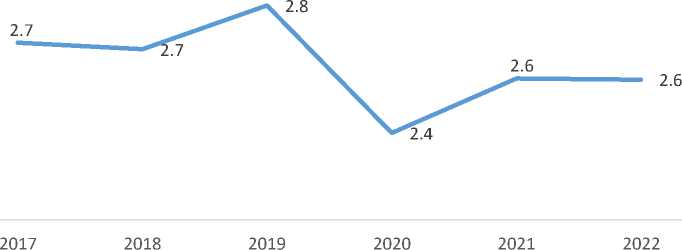
Fig. 1. Dynamics of the contribution of GVA created by tourism to GDP in the Russian Federation, in % of the total 3.
In 2021, the indicator showed positive dynamics, demonstrating the recovery of the industry. At the end of 2022, its value remained the same, not exceeding the pre-pandemic level. It is worth noting that the work of tourism enterprises in 2022 was strongly influenced by the geopolitical situation in the world, which led to a reduction in the volume of outbound tourism due to the introduction of visa restrictions, the lack of direct flights, difficulties with servicing Russian aircraft due to sanctions, as well as to a significant reduction in the number of incoming tourists to Russia. Thus, their number for 2019–2022 decreased by 25.5 times and amounted to about 200 thousand people at the end of 2022, which is much less than in the “Covid” years of 2020 and 2021. 4 This negatively affected the work of tourism enterprises, reducing their contribution to the economy. In these conditions, the main driver of industry development has become domestic tourism, which has recently been given special attention by the authorities in connection with the implementation of the national project “Tourism and hospitality industry”. In this regard, the assessment of the use of the potential of territories promising for tourism development, including the European North of Russia, is being updated, which will reduce the existing imbalances in the consumption of tourist services in the country [27, Leonidova E.G.].
One of the key indicators that allow assessing the demand for tourism infrastructure and the demand for tourism services in the region is statistical data characterizing the activities of collective accommodation facilities (CAFs).
The analysis showed that the dynamics of population demand for the services of hotels, hostels and sanatoriums of the ENR 5 in the post-pandemic period was multidirectional (Fig. 2).

2010 2011 2012 2013 2014 2015 2016 2017 2018 2019 2020 2021 2022
Republic of Karelia Republic of Komi ^^м • Nenets AO
Arkhangelsk Oblast MHMiM^» Vologda Oblast Murmansk Oblast
Fig. 2. Dynamics of the number of persons staying in collective accommodation facilities in the constituent entities of the European North of Russia 6.
In 2021-2022, the most noticeable growth of the indicator was in the Vologda Oblast (62.4%). In 2022, the majority of the ENR subjects, except for the Komi Republic, showed a negative dynamics of demand for accommodation services compared to the previous year. The sharpest decline was recorded in the Republic of Karelia (-36.8%). In the Nenets Autonomous Okrug it was 22%, in the Arkhangelsk and Murmansk oblasts — 16 and 14%, respectively.
In general, in 2022, the leading region in terms of the number of people accommodated in the hotel sector was the Vologda Oblast, which received 604 thousand people. Almost half as many hotel service clients were served in the Republic of Karelia (357 thousand people), Murmansk (307 thousand people) and Arkhangelsk (277 thousand people) oblasts.
Thus, it can be stated that in the post-pandemic period, among those staying in the CAF, accommodation facilities of the Vologda Oblast were in high demand, which accounted for the main flow of visitors among the subjects under consideration. The question arises: what caused this popularity and is it related to the intensification of tourism activity in the region? The outflow of guests from accommodation facilities in the Republic of Karelia, the number of which at the end of 2022 did not exceed the values of the pandemic year 2020, as well as from other subjects of the ENR, also requires assessment.
Analysis of data on the activities of collective accommodation facilities in the Vologda Oblast by months showed that the peak of demand for them was in March and August (Fig. 3).
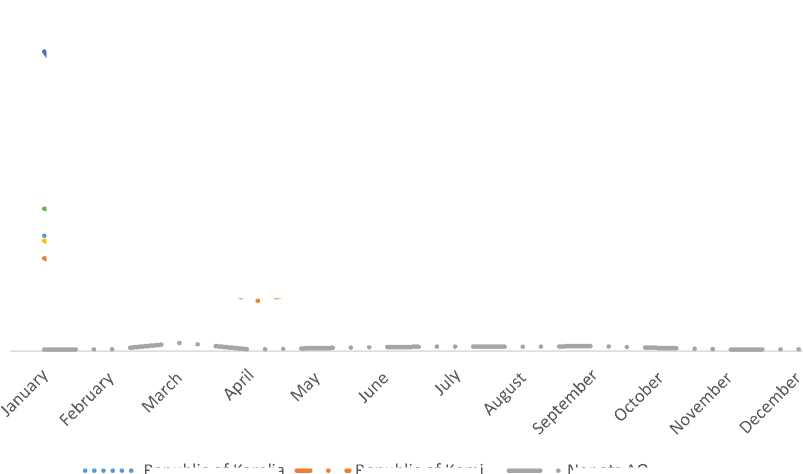
Republic of Karelia
Republic of Komi
Nenets AO
Arkhangelsk Oblast ^ ■■■■■■■■ v Vologda Oblast Murmansk Oblast
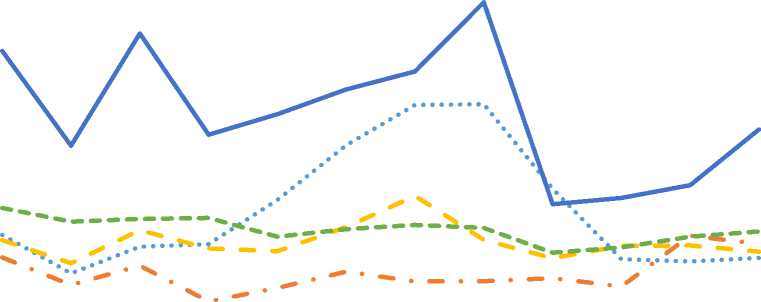
Fig. 3. Dynamics of the number of persons staying in collective accommodation facilities in the constituent entities of the European North of Russia in 2022 7.
It should be noted that the dynamics of the indicator growth in March, which is not the most “tourist” month of the year, was also observed in the Arkhangelsk Oblast and the Nenets Autonomous Okrug. The probable reason for this is the popularity among Russians of tours under the tourist cashback program, which also applied to trips taken in March. Three non-working days (from 6 to 8 March) fell on the period of the program due to the 8th of March holiday.
The reason for the increased demand for accommodation facilities in the Vologda Oblast in August may be the opening of the Arkhangelskiy Bridge in Cherepovets on August 10, 2022. As part of this event, a seven-hour festive program was organized, which was attended, according to estimates, by about 150 thousand people 8. This large-scale event could attract not only city dwellers, but also residents of neighboring areas, which created a demand for accommodation services.
The decline in demand for the hotel sector in most subjects of the ENR, the most noticeable among which was noted in the Republic of Karelia, can be explained by the all-Russian trend: in 2021–2022, the number of people accommodated in the CAF decreased from 66.5 to 64.5 million people. One of the reasons for this may be the growing popularity of outbound tourism, as evi- denced by a 22.6% increase in the number of trips by Russians abroad for tourism purposes during this time interval 9.
The calculations have shown that the territories with high tourist load in the region 10 include the Republic of Karelia, the Vologda and Murmansk oblasts, while the rest of the subjects have a significant potential for increasing the tourist flow (Table 1).
Table 1
Dynamics of tourist load in the subjects of the European North of Russia 11
|
No . |
Subject |
2019 |
2020 |
2021 |
2022 |
Change |
|
1 |
Nenets Autonomous Okrug |
0.30 |
0.19 |
0.26 |
0.21 |
-0.09 |
|
2 |
Komi Republic |
0.28 |
0.18 |
0.24 |
0.25 |
-0.03 |
|
3 |
Arhangelsk Oblast |
0.32 |
0.18 |
0.30 |
0.26 |
-0.06 |
|
4 |
Murmansk Oblast |
0.43 |
0.35 |
0.49 |
0.43 |
0 |
|
5 |
Vologda Oblast |
0.41 |
0.24 |
0.32 |
0.53 |
0.12 |
|
6 |
Republic of Karelia |
0.78 |
0.63 |
0.93 |
0.59 |
-0.19 |
The leadership of the above-mentioned regions is explained by developed infrastructure, more favorable climatic conditions for tourism activities, and high transport accessibility. The most noticeable decrease in the indicator for the analyzed period was noted in the Republic of Karelia. It should be emphasized that by the end of 2021, the number of tourists there was almost equal to the number of residents, which indicates its high tourist attractiveness.
The growth of tourist consumption and, accordingly, the contribution of tourism to the economy of the territories depend on the duration of stay of travelers, which can be judged by the number of overnights in accommodation facilities.
Almost in all the ENR subjects 12, except for the Arkhangelsk Oblast, the indicator according to data for the third quarter of 2022 increased compared to the pre-pandemic level of 2019 (Fig. 4). The most positive dynamics were demonstrated by the Nenets Autonomous Okrug (+39%), which, taking into account the poorly developed tourist infrastructure, low transport accessibility and harsh climatic conditions, can be considered a good result. However, it is worth noting that, given the specifics of the region, the number of people staying in accommodation facilities may include not only tourists, but also business travelers and shift workers. In terms of the number of overnight stays in the third quarter of 2022, the leaders were the Vologda Oblast and the Republic of Karelia.
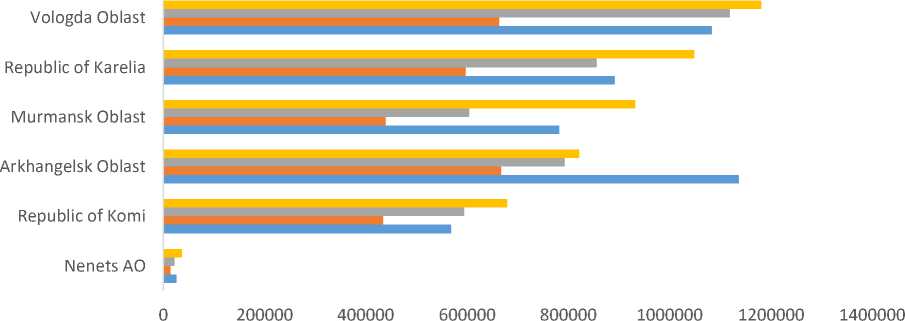
■ 2022 ■ 2021 ■ 2020 ■ 2019
Fig. 4. Dynamics of the number of overnight stays in collective accommodation facilities of the ENR subjects, units 13.
It should be noted that the uniqueness of the European North of Russia is associated, among other things, with the presence of subjects included in the Arctic Zone of the Russian Federation, located in the Murmansk and Arkhangelsk oblasts, the Komi Republic and the Nenets Autonomous Okrug. It is possible to develop Arctic tourism there, which involves traveling to observe the northern lights, diving, snowmobiling, sleigh rides pulled by huskies, reindeer, etc.
One of the problems is the low awareness of tourists about their tourism opportunities. Data from a sociological survey 14 showed that almost 40% of Russians know very little or practically nothing about the Arctic (Fig. 5).
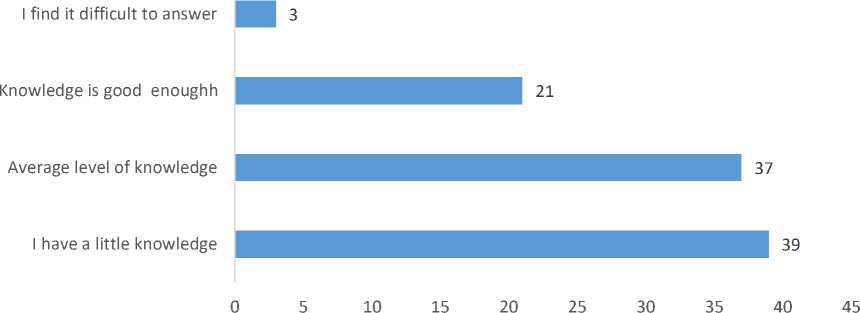
Fig. 5. Distribution of the answer to the question “How do you assess your knowledge about the Arctic zone of Russia as a whole?”, in % of all respondents 15.
-
13 Source: Rosstat data.
-
14 The all-Russian survey was conducted by the NAFI Analytical Center in December 2022. 1600 people 18 years old and older were surveyed in 53 regions of Russia. The sample is based on official statistics from Rosstat and represents the adult population of the Russian Federation by gender, age, level of education and type of settlement. The statistical error of the data does not exceed 3.4%.
-
15 Source: NAFI sociological survey.
Moreover, representatives of the most economically active group of the population — Russians aged 35 to 44 (47%) — have heard the least about it. This requires an active information campaign to promote Arctic tourism.
A vivid example of Arctic tourism is the case of the village of Teriberka in the Murmansk Oblast on the shores of the Barents Sea, which has become a point of attraction for tourists from all over Russia. Currently, 11 projects are being implemented in the village for a total amount of over 1 billion rubles 16. It seems that the active development of other promising territories in the Arctic zone of the European North of Russia can provide no less social and economic effect.
Thus, the analysis revealed the peculiarities of the functioning of the tourism industry of the subjects of the European North of Russia in the post-pandemic period, identified the main trends in demand for tourist services from the population. It can be stated that in the near future, the development of tourism in the ENR will largely be determined by the activity of domestic tourists and the efforts of regional authorities and businesses to increase the competitiveness of the regional tourism product. Solving this problem requires identifying threats that could have a negative impact on the tourism market of the ENR and the volume of domestic tourist flow. Taking into account the current economic and political situation in the country, it seems that the following can be attributed to such threats for the subjects of the European North of Russia:
-
• decrease in the purchasing power of the population and growth of prices for vacations;
-
• unstable economic situation in the country;
-
• active development of tourism in neighboring regions of the Northwestern Federal District;
-
• high level of uncertainty in the functioning of the tourism industry in Russia and high degree of risk in running a tourism business;
-
• growing popularity of outbound tourism.
The emergence of identified threats can lead to a decrease in tourist flow and a reduction in the time tourists spend at their destinations, the reorientation of tourists to other regions with more attractive tourism products and developed transport and infrastructure, and a reduction in spending on tourism services.
In this regard, it seems important to highlight the priorities that determine the development of the tourism industry in the near future:
-
1. Providing support to promising types of tourism that have high development potential and are able to attract mass tourist flow. Thus, one of them is industrial tourism, which involves tourists visiting production facilities. In Russia, this type of tourism has recently been developing very dynamically. For example, in 2022, one of the successful in this direction was the case of Nizhny Novgorod Ob-
- last, the industrial enterprises of which were visited by 78.8 thousand tourists, which is 13% more than last year 17. A prototype of a possible route through industrial enterprises of the Nizhny Novgorod Oblast was also created, uniting 15 municipalities. In the Republic of Karelia, according to experts, potential points of growth of industrial tourism may be the park “White Mountain. Tivdi Marble” park in the Kondopoga district, Yuven Island in the Pitkyaranta district, and the mine of the Tulomazerskiy Plant in the Pryazhinskiy district 18. For the active development of this direction in the constituent entities of the European North of Russia, it is necessary to create a register of enterprises open to tourists and formulate a program for the development of industrial tourism in the regions. This can be achieved by consolidating the efforts of regional authorities, business representatives and attracting experts from the Agency for Strategic Initiatives, on the basis of which, with the support of the Ministry of Industry and Trade of the Russian Federation, a special acceleration program has been created, aimed at implementing an industrial tourism model.
-
2. Targeted subsidies for tourist trips within the region for certain categories of citizens (children, pensioners, low-income families, etc.). Currently, the Russian government has allocated 1 billion rubles for a program of free school trips as part of the national project “Tourism and hospitality industry” for 29 Russian regions. The Vologda Oblast is the only participant in the school tourism program among the constituent entities of the European North of Russia. At the end of 2022, about three thousand schoolchildren were sent on trips as part of the project. In 2023, it is planned to double their number. Financial incentives for travel for retirees are promising. Thus, in the Republic of Bashkiria, within the framework of the project “Bashkir Longevity. Tourism”, free travel is available for pension-
ers 19. At the end of 2022, 10 thousand pensioners became participants in the program, which is 2.5 times more than in 2021.
-
3. Intensification of interaction between the ENR subjects within the framework of the implementation of the interregional historical and cultural project “Silver Necklace”, uniting 11 regions of North-West Russia.
Ecological tourism is another promising area that can ensure the growth of tourist flow. The European North has a significant potential for its development: specially protected natural areas, serving as an eco-tourism resource, occupy 13.1% of the Komi Republic, which is explained by the location of the largest natural park “Yugyd Va” — a UNESCO site. The main reason hindering its development is the poor legislation. In the near future, a draft law on tourism in specially protected natural areas is expected to be adopted, which will significantly increase the attendance of the region.
Event tourism, which receives significant financial support from federal authorities, can become a driver for the development of territories. For example, the Russian government allocated 638 million rubles for its development in 2023 to support and promote such projects. Moreover, only 2 subjects of the European North of Russia were among the recipients of subsidies: the Arkhangelsk Oblast and the Republic of Karelia. At the same time, the other territories also have a high potential for its development.
Despite the pool of tourist routes formed over a ten-year period, not many interregional routes have been created. Basically, within the framework of the project, each entity promotes tours within its region, without including the proposals of its neighbors in the program, as a result of which the meaning of the project is lost — the general promotion of tourist opportunities of the territory. In addition, information and marketing support needs to be improved. The currently existing single resource with a description of the project’s tourist routes offers only reference and introductory information. There is no option to book a tour directly.
The implementation of these directions for the development of tourism in the European North of Russia will make it possible to mitigate the identified risks of a decline in tourism activity and increase the volume of domestic tourist consumption. It should be noted that the success of their implementation largely depends on the activity of regional authorities in attracting federal funding and creating favorable conditions for investors.
Conclusion
The study made it possible to identify the following trends that determine the development of tourism in the European North of Russia after the coronavirus pandemic:
-
• the majority of the ENR subjects have not reached the level of 2019 in terms of the volume of demand from the population for hotel sector services;
-
• the revival of demand for tourism resources in the European North of Russia in the postpandemic period was significantly facilitated by the tourist cashback program, which increased hotel occupancy;
-
• the most attractive territories for tourists are the Republic of Karelia, Vologda and Murmansk oblasts, which account for 72% of all overnight stays in the region;
-
• the length of stay in accommodation facilities has increased compared to the 2019 level.
Thus, the study allowed us to conclude that the development of the tourism industry of the European North of Russia in the post-Covid period in terms of key indicators did not reach pre-pandemic levels, which requires the identification of new vectors for its development and the active use of the existing unique tourism potential.
Taking into account the significant financial support provided to tourism at the federal level within the framework of the national project “Tourism and hospitality industry”, it is necessary to
NORTHERN AND ARCTIC SOCIETIES
Ekaterina G. Leonidova. Tourism in the Subjects of the European North of Russia … strengthen local work on the inclusion of tourism projects of the ENR subjects in the number of recipients of subsidies within the framework of the project.
The study confirmed the adequacy of the approach to analyzing the assessment of tourism development in the regions, based on the diagnosis of indicators characterizing the functioning of the tourism infrastructure in general and the hotel sector in particular. The proposed approach allows assessing the tourism industry in terms of supply and demand to identify threats and develop measures to improve its development, and can be tested on the example of any region and municipality due to the availability of data.
Список литературы Tourism in the Subjects of the European North of Russia after the COVID-19: Assessment of the State and Prospects of Development
- Skare M., Soriano D.R., Porada-Rochoń M. Impact of COVID-19 on the Travel and Tourism Industry. Technological Forecasting and Social Change, 2020, vol. 163, 120469. DOI: 10.1016/j.techfore.2020.120469
- Leonidova E.G. Prioritety i ugrozy razvitiya regional'nogo turizma [Priorities and Threats for the De-velopment of Regional Tourism]. Regionologiya [Regionology. Russian Journal of Regional Studies], 2022, vol. 30, no. 3, pp. 624–646. DOI: 10.15507/2413-1407.120.030.202203.624-646
- Lukin E.V., Leonidova E.G., Sidorov M.A. Stimulirovanie vnutrennego sprosa kak faktora ekonomich-eskogo rosta (na primere sfery vnutrennego turizma) [Boosting Domestic Demand as a Driving Force of Economic Growth (on the Example of Domestic Tourism Sphere)]. Ekonomicheskie i sotsial'nye peremeny: fakty, tendentsii, prognoz [Economic and Social Changes: Facts, Trends, Forecast], 2018, vol. 11, no. 4, pp. 125–143. DOI: 10.15838/esc.2018.4.58.8
- Leonidova E.G., Sidorov M.A. Strukturnye izmeneniya ekonomiki: poisk otraslevykh drayverov rosta [Structural Changes in the Economy: Searching for Sectoral Drivers of Growth]. Ekonomicheskie i sotsial'nye peremeny: fakty, tendentsii, prognoz [Economic and Social Changes: Facts, Trends, Fore-cast], 2019, vol. 12, no. 6, pp. 166–181. DOI: 10.15838/esc.2019.6.66.9
- Grushenko E.B., Lisunova E.A. Aktual'nye aspekty razvitiya turizma v regionakh Evropeyskogo Severa Rossii i Zapadnoy Arktiki: monografiya [Current Aspects of Tourism Development in the Regions of the European North of Russia and the Western Arctic]. Apatity, FRC KSC RAS Publ., 2021, 110 p. DOI: 10.37614/978.5.91137.451.8 (In Russ.)
- Kondrateva S.V. Tourism Development in the Regions of the European North. Arktika i Sever [Arctic and North], 2022, no. 47, pp. 164–187. DOI: 10.37482/issn2221-2698.2022.47.164
- Rogerson C.M., Rogerson J.M. COVID-19 and Changing Tourism Demand: Research Review and Poli-cy Implications for South Africa. African Journal of Hospitality, Tourism and Leisure, 2021, vol. 10 (1), pp. 1–21. DOI: 10.46222/ajhtl.19770720-83
- Duro J.A., Perez-Laborda A., Fernandez M. Territorial Tourism Resilience in the COVID-19 Summer. Annals of Tourism Research Empirical Insights, 2022, vol. 3, iss. 1, 100039. DOI: 10.1016/j.annale.2022.100039
- Arbulú I., Razumova M., Rey-Maquieira J., Sastre F. Can Domestic Tourism Relieve the COVID-19 Tourist Industry Crisis? The Case of Spain. Journal of Destination Marketing and Management, 2021, vol. 20, 100568. DOI: 10.1016/j.jdmm.2021.100568
- Gössling S., Scott S., Hall M. Pandemics, Tourism, and Global Change: A Rapid Assessment of COVID-19. Journal of Sustainable Tourism, 2020, vol. 29, pp. 1–20. DOI: 10.1080/09669582.2020.1758708
- Kreiner N.C., Ram Y. National Tourism Strategies during the COVID-19 Pandemic. Annals of Tourism Research, 2021, vol. 89, 103076. DOI: 10.1016/j.annals.2020.103076
- Woyo E. The Sustainability of Using Domestic Tourism as a Post-COVID-19 Recovery Strategy in a Distressed Destination. In: Information and Communication Technologies in Tourism 2021. 2021, pp 476–489. DOI: 10.1007/978-3-030-65785-7_46
- Nguyen C.P., Su T.D. Domestic Tourism Spending and Economic Vulnerability. Annals of Tourism Re-search, 2020, vol. 85, 103063. DOI: 10.1016/j.annals.2020.103063
- Simonyan G.A., Saryan A.A. Strategicheskie tseli i zadachi razvitiya vnutrennego turizma v novykh usloviyakh [Strategic Goals and Objectives of the Development of Domestic Tourism in New Condi-tions]. Sovremennaya nauchnaya mysl' [Modern Scientific Thought], 2022, no. 6, pp. 266–273. DOI: 10.24412/2308-264X-2022-6-266-273
- Donskova L.I., Barannikov A.L., Makovetsky M.U. Sostoyanie vnutrennego turizma v Rossii v sov-remennyy period: kolichestvennyy i kachestvennyy analiz [The State of Domestic Tourism in Russia in the Modern Period: Quantitative and Qualitative Analysis]. Vestnik akademii znaniy [Bulletin of the Academy of Knowledge], 2022, no. 52 (5), pp. 127–136.
- Moroshkina M.V., Kondrateva S.V. Regional'naya dostupnost' kak faktor razvitiya turistskogo napravleniya [Regional Accessibility as a Factor in the Development of a Tourist Destination]. Re-gionologiya [Russian Journal of Regional Studies], 2021, vol. 29, no. 1, pp. 60–81. DOI: 10.15507/2413-1407.114.029.202101.060-081
- Ivanov I.A., Vasilyeva T.V., Krasilnikova I.N., Manakov A.G. Vnutrenniy turizm v munitsipal'nykh obrazovaniyakh SZFO: statisticheskie otsenki i vliyanie pandemii COVID-19 [Domestic Tourism in the NWFD Municipalities: Statistical Estimations and the Impact of the Covid-19 Pandemic]. Izvestiya Russkogo geograficheskogo obshchestva [Proceedings of the Russian Geographical Society], 2022, vol. 154, no. 5–6, pp. 59–72. DOI: 10.31857/S0869607122050044
- Manakov A.G., ed. Vidy turizma i geografiya turpotokov v zerkale pandemii COVID-19: monografiya [Types of Tourism and Geography of Tourist Flows in the Mirror of the Covid-19 Pandemic]. Pskov, Pskov State University Publ., 2022, 214 p. (In Russ.)
- Orlova V.S. Potentsial sfery turizma i rekreatsii Evropeyskogo Severa: otsenka i napravleniya razviti-ya v usloviyakh osvoeniya Arktiki [Potential of the Tourism and Recreation Sphere in the European North: Evaluation and Development Vector in Terms of the Arctic Development]. Ekonomicheskie i sotsial'nye peremeny: fakty, tendentsii, prognoz [Economic and Social Changes: Facts, Trends, Fore-cast], 2021, vol. 14, no. 1, pp. 141–153. DOI: 10.15838/esc.2021.1.73.10
- Yakovchuk A.A. Tourism Industry Development Issues in the Arctic zone of the Russian Federation. Arktika i Sever [Arctic and North], 2020, no. 38, pp. 55–72. DOI: 10.37482/issn2221-2698.2020.38.56
- Pospelova S.V., Kutyeva E.R. Resursy razvitiya etnicheskogo turizma na territorii Arkticheskoy chasti Rossii [Resources for the Development of Ethnic Tourism in the Territory of the Arctic Part of Rus-sia]. Mezhdunarodnyy zhurnal gumanitarnykh i estestvennykh nauk [International Journal of Hu-manities and Natural Sciences], 2022, no. 3-3 (66), pp. 211–214. DOI: 10.24412/2500-1000-2022-3-3-211-214
- Kozhevnikov S.A., Sekushina I.A. Mezhregional'noe sotrudnichestvo: opyt regionov Evropeyskogo Severa Rossii [Interregional Cooperation: Experience of the Regions of the European North of Rus-sia]. Vestnik Volgogradskogo gosudarstvennogo universiteta. Ekonomika [Journal of Volgograd State University. Economics], 2021, vol. 23, no. 4, pp. 56–70. DOI: 10.15688/ek.jvolsu.2021.4.5
- Leonidova E.G., Sidorov M.A. Otsenka i prognoz vnutrennego turisticheskogo potrebleniya v Rossii [Assessment and Forecast of Domestic Tourism Consumption in Russia]. Problemy prognozirovaniya [Studies on Russian Economic Development], 2023, no. 1 (196), pp. 193–205. DOI: 10.47711/0868-6351-196-193-205
- Ovcharov A.O. Klassifikatsiya vidov ekonomicheskoy deyatel'nosti v turistskom segmente ekonomiki [Classification of Economic Activities in the Tourism Segment of the Economy]. Voprosy statistiki, 2014, no. 8, pp. 40–45. DOI: 10.34023/2313-6383-2014-0-8-40-45
- Ovcharov A.O. K voprosu o sovershenstvovanii statisticheskogo ucheta turistskikh poezdok v uslovi-yakh krizisa [On the Improvement of Statistical Accounting for Tourist Trips Amidst Crisis]. Voprosy statistiki, 2021, no. 28 (2), pp. 67–79. DOI: 10.34023/2313-6383-2021-28-2-67-79
- Leonidova E.G. Turizm v Rossii v usloviyakh COVID-19: otsenka ekonomicheskogo effekta ot stimuli-rovaniya sprosa dlya strany i regionov [Russian Tourism during the Covid-19: Assessing Effect of Stimulating Domestic Demand for the Country and Regions' Economy]. Ekonomicheskie i sotsial'nye peremeny: fakty, tendentsii, prognoz [Economic and Social Changes: Facts, Trends, Forecast], 2021, vol. 14, no. 2, pp. 59–74. DOI: 10.15838/esc.2021.2.74.4
- Ivanov I.A. Regional'nye i sezonnye osobennosti v'ezdnogo turizma v Islandiyu [Regional and Sea-sonal Features of Inbound Tourism in Iceland]. Geograficheskiy vestnik [Geographical Bulletin], 2021, no. 3 (58), pp. 169–179. DOI: 10.17072/2079-7877-2021-3-169-179

